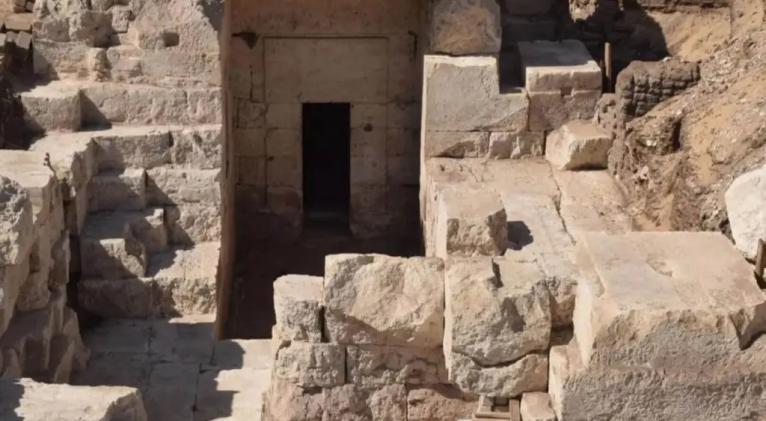 Egypt, Dec 3. - A team of German and Egyptian archaeologists, led by experts from the University of Tübingen, has unearthed the entrance to a majestic stone temple in the ancient city of Athribis, near Sohag, Egypt. This find, which has captured the attention of the international scientific community, offers new clues about the architectural and cultural mysteries of the Ptolemaic era. The research, originally published in Sci.news, details the unique features of this structure that date back to the reign of Ptolemy VIII (182-116 BC).
Egypt, Dec 3. - A team of German and Egyptian archaeologists, led by experts from the University of Tübingen, has unearthed the entrance to a majestic stone temple in the ancient city of Athribis, near Sohag, Egypt. This find, which has captured the attention of the international scientific community, offers new clues about the architectural and cultural mysteries of the Ptolemaic era. The research, originally published in Sci.news, details the unique features of this structure that date back to the reign of Ptolemy VIII (182-116 BC).
The door to the past
The team has discovered that the entrance to the temple was flanked by a large two-towered pylon, the remains of which originally rose to 18 meters. Although much of the structure was dismantled during the VIII century AD. for its reuse as a quarry, archaeologists managed to recover significant elements of its decoration, such as reliefs depicting the pharaoh offering sacrifices to the lioness goddess Repit and her son Kolanthes.
According to Professor Christian Leitz, director of the project, the monumentality and artistic details of this construction make it a key piece to understand the temples of the Hellenistic period in Egypt.
Among the most intriguing finds is a hidden chamber inside the north tower of the pylon. This space, 6 meters long and 3 meters wide, was unearthed after removing a 20-tonne roof block using innovative excavation techniques, such as air cushions and wooden rollers. Originally, this chamber served to store temple utensils, although it was later used to store amphorae.
A unique architecture in Egypt
The design of the temple of Athribis presents features unusual in Egyptian temple architecture. A second door was found in the pylon, leading to a hidden staircase with at least four flights that connected to a now-disappeared upper floor. This architectural arrangement, together with a finely carved limestone facade, suggests the existence of a rock-cut sanctuary behind the temple.
The hieroglyphic decoration of the entrance is also fascinating. It includes representations of the god Min, a fertility deity, accompanied by two star figures known as decans, one with a falcon head and the other with an ibis head. These figures, rarely represented in Egyptian art, had an astronomical function: to measure time during the night.
According to Leitz, the reliefs and symbolism of the temple not only reinforce the religious importance of the place, but also reflect a deep connection with the celestial cycles and fertility, fundamental pillars of the Egyptian worldview of that time.
A journey to the secrets of Ptolemy VIII
The reign of Ptolemy VIII, the monarch associated with the construction of the temple, was marked by a mix of dynastic conflicts and cultural advances. Although his figure has been historically controversial due to his reputation as a ruthless leader, the inscriptions found at Athribis show a different aspect: a ruler concerned with promoting religion and architectural monumentality.
The temple's pylon, with reliefs showing Ptolemy VIII in acts of devotion, seems to have been designed to reinforce his legitimacy and connection with Egyptian divinities. This aspect is especially relevant considering that, during the Ptolemaic era, pharaohs of Macedonian origin sought to balance their Hellenic identity with Egyptian traditions.
The challenges of conservation
The excavation at Athribis has faced multiple challenges, from removing debris to preserving the hieroglyphic inscriptions, many of which are deteriorated due to the passage of time and the extraction of materials in past centuries. However, technological advances and international collaboration have made it possible to preserve important fragments that could reveal more secrets about the religious and daily life of this ancient city.
In addition, the project has encouraged the active participation of local archaeologists, which reinforces Egypt's commitment to preserving its historical heritage. Mohamed Abdelbadia, from the Supreme Council of Antiquities of Egypt, has highlighted that the discovery not only provides information about ancient history, but also reinforces cultural tourism in the region.
A discovery with future projection
Although the temple of Athribis has already provided a treasure trove of information, archaeologists believe that there is still much to discover. According to Professor Leitz, there is a high probability that behind the carved facade lies an intact rock sanctuary. "The more than three meters of height of this facade and its decorative details indicate that there could be a hidden door leading to an unexplored sanctuary," he said in statements collected by Sci.news.
This possible sanctuary could contain additional artifacts or inscriptions that would shed more light on the religious practices and cultural life of the Ptolemaic era, consolidating Athribis as one of the most important archaeological sites in Egypt. (Text and Photo: Cubasí)